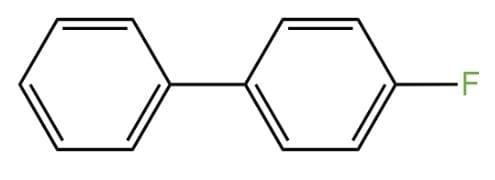

(A)

(B)

(C)

(D)

Answer
220.8k+ views
Hint: Aniline is an organic compound in which $N{{H}_{2}}$ group is attached to a benzene ring. It is also known as phenylamine. This compound gets dark when exposed to air and light. It is a highly toxic compound. The behaviour of aniline is somewhat similar to that of primary aliphatic amines. It boils at a temperature of ${{183}^{o}}C$.
Complete Step by Step Answer:
Aniline and $HN{{O}_{2}}$ combine in the first step to produce diazonium salt, which is then combined with hydrogen fluoride ($HF$) and fluoroboric acid ($B{{F}_{3}}$) to create fluoro benzene ($PhF$). Fluorobenzene is a colourless liquid having the molecular formula ${{C}_{6}}{{H}_{5}}F$. It is also known as phenyl fluoride. It is a flammable substance.

Correct Option: (D) $Ph-F$.
Additional Information: The reagent, nitrous acid ($HN{{O}_{2}}$), which is used to convert aniline to diazonium salt, is prepared by the reaction of sodium nitrite ($NaN{{O}_{2}}$) and hydrochloric acid ($HCl$). The diazonium salt formed is unstable at room temperature and is usually prepared at a very low temperature (${{0}^{o}}-{{5}^{o}}C$). Diazonium salts, in general, are high-energy substances that can violently break down when heated or forced mechanically (shock-sensitive). It is an important intermediate for producing substituted benzene.
Note: Aniline is a highly used compound in the clothing industry. It is used as a dyeing agent. For the manufacturing of rubber chemicals and goods like automobile tyres, balloons, gloves, etc., anilines are employed in the rubber industry. Insecticide and reagents for plastic and resin polymers are uses of fluorobenzene.
Complete Step by Step Answer:
Aniline and $HN{{O}_{2}}$ combine in the first step to produce diazonium salt, which is then combined with hydrogen fluoride ($HF$) and fluoroboric acid ($B{{F}_{3}}$) to create fluoro benzene ($PhF$). Fluorobenzene is a colourless liquid having the molecular formula ${{C}_{6}}{{H}_{5}}F$. It is also known as phenyl fluoride. It is a flammable substance.

Correct Option: (D) $Ph-F$.
Additional Information: The reagent, nitrous acid ($HN{{O}_{2}}$), which is used to convert aniline to diazonium salt, is prepared by the reaction of sodium nitrite ($NaN{{O}_{2}}$) and hydrochloric acid ($HCl$). The diazonium salt formed is unstable at room temperature and is usually prepared at a very low temperature (${{0}^{o}}-{{5}^{o}}C$). Diazonium salts, in general, are high-energy substances that can violently break down when heated or forced mechanically (shock-sensitive). It is an important intermediate for producing substituted benzene.
Note: Aniline is a highly used compound in the clothing industry. It is used as a dyeing agent. For the manufacturing of rubber chemicals and goods like automobile tyres, balloons, gloves, etc., anilines are employed in the rubber industry. Insecticide and reagents for plastic and resin polymers are uses of fluorobenzene.
Recently Updated Pages
Difference Between Alcohol and Phenol: Structure, Tests & Uses

Classification of Drugs in Chemistry: Types, Examples & Exam Guide

Class 12 Chemistry Mock Test Series for JEE Main – Free Online Practice

Is PPh3 a strong ligand class 12 chemistry JEE_Main

Full name of DDT is A 111trichloro22bispchlorophenyl class 12 chemistry JEE_Main

Sodium acetate on heating with soda lime produce A class 12 chemistry JEE_Main

Trending doubts
JEE Main 2026: Application Form Open, Exam Dates, Syllabus, Eligibility & Question Papers

Derivation of Equation of Trajectory Explained for Students

Hybridisation in Chemistry – Concept, Types & Applications

Understanding the Angle of Deviation in a Prism

How to Convert a Galvanometer into an Ammeter or Voltmeter

Degree of Dissociation: Meaning, Formula, Calculation & Uses

Other Pages
Solutions Class 12 Chemistry Chapter 1 CBSE Notes - 2025-26

NCERT Solutions For Class 12 Chemistry Chapter 1 Solutions - 2025-26

The D and F Block Elements Class 12 Chemistry Chapter 4 CBSE Notes - 2025-26

NCERT Solutions for Class 12 Chemistry Chapter Chapter 7 Alcohol Phenol and Ether

NCERT Solutions ForClass 12 Chemistry Chapter Chapter 8 Aldehydes Ketones And Carboxylic Acids

JEE Advanced Marks vs Ranks 2025: Understanding Category-wise Qualifying Marks and Previous Year Cut-offs




